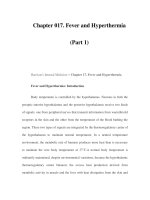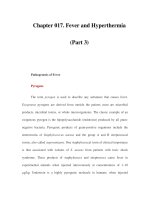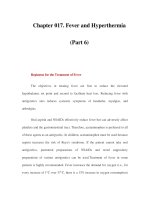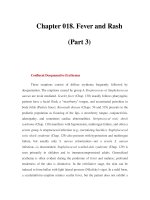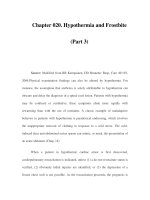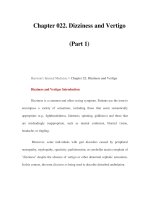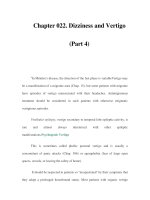Chapter 022. Dizziness and Vertigo (Part 3) doc
Bạn đang xem bản rút gọn của tài liệu. Xem và tải ngay bản đầy đủ của tài liệu tại đây (15.98 KB, 6 trang )
Chapter 022. Dizziness and Vertigo
(Part 3)
Recurrent unilateral labyrinthine dysfunction, in association with signs and
symptoms of cochlear disease (progressive hearing loss and tinnitus), is usually
due to Ménière's disease (Chap. 30). When auditory manifestations are absent, the
term vestibular neuronitis denotes recurrent monosymptomatic vertigo. Transient
ischemic attacks of the posterior cerebral circulation (vertebrobasilar
insufficiency) only infrequently cause recurrent vertigo without concomitant
motor, sensory, visual, cranial nerve, or cerebellar signs (Chap. 364).
Positional vertigo is precipitated by a recumbent head position, either to the
right or to the left. Benign paroxysmal positional (or positioning) vertigo (BPPV)
of the posterior semicircular canal is particularly common. Although the condition
may be due to head trauma, usually no precipitating factors are identified. It
generally abates spontaneously after weeks or months. The vertigo and
accompanying nystagmus have a distinct pattern of latency, fatigability, and
habituation that differs from the less common central positional vertigo (Table 22-
1) due to lesions in and around the fourth ventricle. Moreover, the pattern of
nystagmus in posterior canal BPPV is distinctive. When supine, with the head
turned to the side of the offending ear (bad ear down), the lower eye displays a
large-amplitude torsional nystagmus, and the upper eye has a lesser degree of
torsion combined with upbeating nystagmus. If the eyes are directed to the upper
ear, the vertical nystagmus in the upper eye increases in amplitude. Mild
dysequilibrium when upright may also be present.
Table 22-1 Benign Paroxysmal Positional Vertigo and Central
Positional Vertigo
Features BPPV Central
Latency
a
3–40 s None: immediate
vertigo and nystagmus
Fatigability
b
Yes No
Habituation
c
Yes No
Intensity of vertigo Severe Mild
Reproducibility
d
Variable Good
a
Time between attaining head position and onset of symptoms.
b
Disappearance of symptoms with maintenance of offending position.
c
Lessening of symptoms with repeated trials.
d
Likelihood of symptom production during any examination session.A
perilymphatic fistula should be suspected when episodic vertigo is precipitated by
Valsalva or exertion, particularly upon a background of a stepwise progressive
sensory-neural hearing loss. The condition is usually caused by head trauma or
barotrauma or occurs after middle ear surgery.
Vertigo of Vestibular Nerve Origin
This occurs with diseases that involve the nerve in the petrous bone or the
cerebellopontine angle. Although less severe and less frequently paroxysmal, it
has many of the characteristics of labyrinthine vertigo. The adjacent auditory
division of the eighth cranial nerve is usually affected, which explains the frequent
association of vertigo with unilateral tinnitus and hearing loss. The most common
cause of eighth cranial nerve dysfunction is a tumor, usually a schwannoma
(acoustic neuroma) or a meningioma. These tumors grow slowly and produce such
a gradual reduction of labyrinthine output that central compensatory mechanisms
can prevent or minimize the vertigo; auditory symptoms are the most common
manifestations.
Central Vertigo
Lesions of the brainstem or cerebellum can cause acute vertigo, but
associated signs and symptoms usually permit distinction from a labyrinthine
etiology (Table 22-2). Occasionally, an acute lesion of the vestibulocerebellum
may present with monosymptomatic vertigo indistinguishable from a
labyrinthopathy.Table 22-2 Features of Peripheral and Central Vertigo
Sign or
Symptom
Peripheral
(Labyrinth)
Central
(Brainstem or
Cerebellum)
Direction of
associated nystagmus
Unidirectional; fast
phase opposite lesion
a
Bidirectional or
unidirectional
Purely
horizontal nystagmus
Uncommon Common
without torsional
component
Vertical or
purely torsional
nystagmus
Never present May be present
Visual fixation Inhibits nystagmus
and vertigo
No inhibition
Severity of
vertigo
Marked Often mild
Direction of
spin
Toward fast phase Variable
Direction of fall
Toward slow phase Variable
Duration of
symptoms
Finite (minutes, days,
weeks) but recurrent
May be chronic
Tinnitus and/or
deafness
Often present Usually absent
Associated
CNS abnormalities
None Extremely common
(e.g., diplopia, hiccups,
cranial neuropathies,
dysarthria)
Common
causes
BPPV, infection
(labyrinthitis), Ménière's,
neuronitis, ischemia,
trauma, toxin
Vascular,
demyelinating, neoplasm
